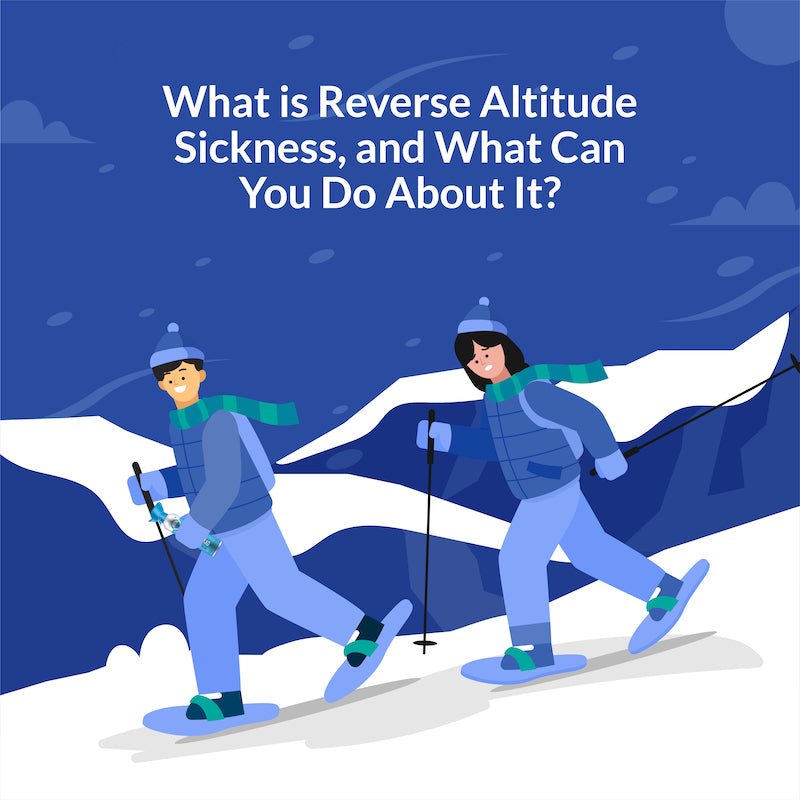Your Cart is Empty
Free Shipping on orders over $75!
Reverse altitude sickness is a condition that might not be as well-known as altitude sickness, but it is just as important to understand, especially for people who frequently travel to and from high altitude areas. In this article, we’ll cover the most critical information regarding reverse altitude sickness, including information about its symptoms and some solutions.
Reverse Altitude Sickness or High-Altitude De Acclimatization Syndrome (HADAS) is a significant public health concern that arises when individuals acclimated to high altitudes return to lower altitudes or sea level, which leads to a loss of high-altitude acclimatization.
Essentially, HADAS is a rapid reoxygenation injury that leads to inflammation with acute and chronic complications. Cardiovascular, blood, and respiratory system abnormalities are observed in individuals experiencing HADAS. Moreover, the symptoms can persist for many years in severe cases, significantly impairing the quality of life of affected individuals.
Traditionally, altitude sickness is related to ascending to high altitudes, where air pressure is lower. Conversely, reverse altitude sickness occurs upon rapid descent, as the body struggles to adapt to the sudden increase in available oxygen and air pressure. Interestingly, the symptoms of altitude sickness and reverse altitude sickness are very similar.
The phenomenon is rooted in the body’s acclimatization to reduced oxygen levels at elevated altitudes. At higher altitudes, the human body undergoes physiological adjustments, such as increased respiration rate and production of more red blood cells to compensate for the lower oxygen availability. As individuals descend, the sudden surge in oxygen levels and air pressure can throw the body’s adapted physiological mechanisms into disarray.
People who have spent an extended period at high altitudes (3-7 weeks), especially those who live at high altitudes are the most likely to develop HADAS. Mountaineers, hikers and skiers who spend significant time at high altitudes and then descend rapidly are also susceptible to HADAS. When these individuals travel to lower elevations, their bodies, acclimated to the high-altitude conditions, may grapple with readjustment, instigating reverse altitude sickness symptoms.

Individuals who descend rapidly after staying at high elevation for an extended period may experience the following symptoms:
The duration of HADAS symptoms can vary depending on the underlying health of the individual, the duration spent at the high altitude and the speed of descent. Typically, HADAS symptoms last for a few days as the body readjusts to the lower altitude conditions, but symptoms can last for years.
Preventing reverse altitude sickness is helped with a gradual descent from high altitudes, allowing the body time to readjust to the ability to process changing blood oxygen levels and atmospheric pressure. Spending a day or two at intermediate altitudes during descent can help in acclimatization and the prevention of HADAS symptoms.
Treating reverse altitude sickness (HADAS) remains a major challenge for medical professionals. The foundational approach to treatment incorporates ample rest and hydration, providing the body with the necessary support to navigate the transition to increased oxygen levels and air pressure. In more severe cases Hyperbaric Oxygen Treatment (HBOT) may be administered and studies have found traditional Chinese medicine to be effective in treating the inflammatory response that is a result of reoxygenation injury.

While not a replacement for medical oxygen or the treatment of serious oxygen-related conditions such as altitude sickness or reverse altitude sickness (HADAS), Oxygen Plus (O+) is a great tool for anyone who regularly travels to and from lower altitudes to higher altitudes. In its ability to deliver more than five times the concentration of oxygen found in everyday air, Oxygen Plus effectively restores depleted oxygen levels in the body to optimal levels, helping you feel like your best you again. Lightweight and pocket-friendly, the O+ Skinni is a great travel companion on high elevation hikes – packing 50+ breaths of pure oxygen in a sleek canister for on-demand, natural energy and recovery.
